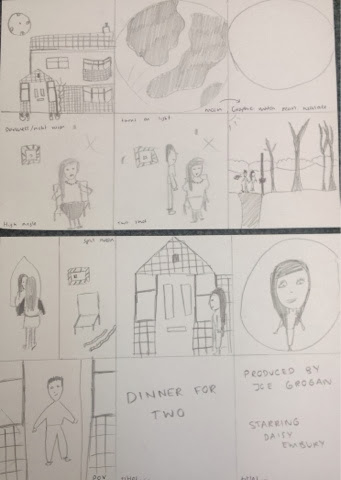Wednesday, 26 March 2014
Tuesday, 25 March 2014
Wednesday, 19 March 2014
Thursday, 13 March 2014
storyboard final
1) The establishing shot of the house (at night time/ evening) preferably evening so that the lighting is dim and eerie.
2) Zoom to the moon.
3) Graphic match to a pearl on the girl's necklace.
4) High angle shot of the girl sitting tied up in a basement in darkness. (night vision camera effect)
5) A man walks in, turning the light on (potentially grabbing her face)
6) A long distance shot, panning the woodland area catching the two walking along holding hands.
7) A split screen shot.
- left hand side; the girl getting ready in the mirror wearing a dressing gown.(high angle)
- right hand side; a man preparing the basement area with ropes/ chair. (low angle)
8) A shot of the girl walking along the house (panning) up to the front door.
9) A fish eye/ crab shot of the girl through the peep hole.
10) The man opening the door and welcoming her in.
11) DINNER FOR TWO
12) Credits.
Tuesday, 11 March 2014
characters
Characters
Daisy Embury:
This is our character we will use for the female character who is the victim in the opening. For the opening we will need to make daisy look ill in the opening as she is being locked in a small space which is dark and warm; for this we will make her look sweaty/ pale. By doing this we will use pale make up and make her look sticky by make her forehead wet. Moreover throughout the piece we want to make her look as average as we can (reflective of mise-en-scene in thriller research)- because the characters traditionally throughout are average and therefore more relatable we would want her to be dressed in plan, darker clothing with not much make up (bare minimum).

Dan Dodd:
Throughout the opening Dan's head will be cut off, yet when it comes to him preparing the room and sending the text we reveal the character still unaware to the audience if it is the same man or not. For Dan's character we will want him to play someone with very little emotion throughout as he will then appear more mysterious and therefore building tension for the audience. Dan will also be dressed in everyday clothes which will be dull and insignificant.
Wednesday, 5 March 2014
Storyboard research
The Process of Story Boarding
Storyboarding is a process that many film production companies utilise in order to organise scenes into seperate shots, allowing them to ponder ideas before actually shooting a scene. The process involves collating a number of different sketches and assembling them in a chronological fashion to form a full scene taking into account the lighting, camera, mise en scene and editing that is projected to be used in the scene whilst annotations are made to get ideas across clearly. Joe Ranft was a very famous storyboarder/voice acotr/screen writer who worked on every Pixar animation project from 1980-2005 before he tragically passed away. He would collect a plethora of sketches that eventually form the basis of the storyboard, before selecting which shots seem most viable and organising them accordingly. Storyboarding is an incredibly beneficial process financially, as it means actors on lucrative salaries are not being paid for more hours than they are actually required for as the scenes have been planned.
The photo above depicts Joe Ranft organising one of many storyboards for Disney Pixar.
Researching story boarding is certainly relevant to our project is it could save us time when filming, as we will have prepared an array of sketches that represent camera angles that we project to film, and will therefore allow us more time to edit/re-film certain scenes. We are going to devise a storyboard with annotations, that is meticulous and takes into account every camera angle/editing techniques we are going to use.
Storyboarding will benefit us greatly in our task, if we have a clear plan as to what we want to shoot, it will make filming more concise and therefore we have more time to edit. The storyboard can be a short sequence of pictures, or an intricate and comprehensive plan that includes almost every shot the director intends to use.
Storyboarding will benefit us greatly in our task, if we have a clear plan as to what we want to shoot, it will make filming more concise and therefore we have more time to edit. The storyboard can be a short sequence of pictures, or an intricate and comprehensive plan that includes almost every shot the director intends to use.
Subscribe to:
Comments (Atom)







